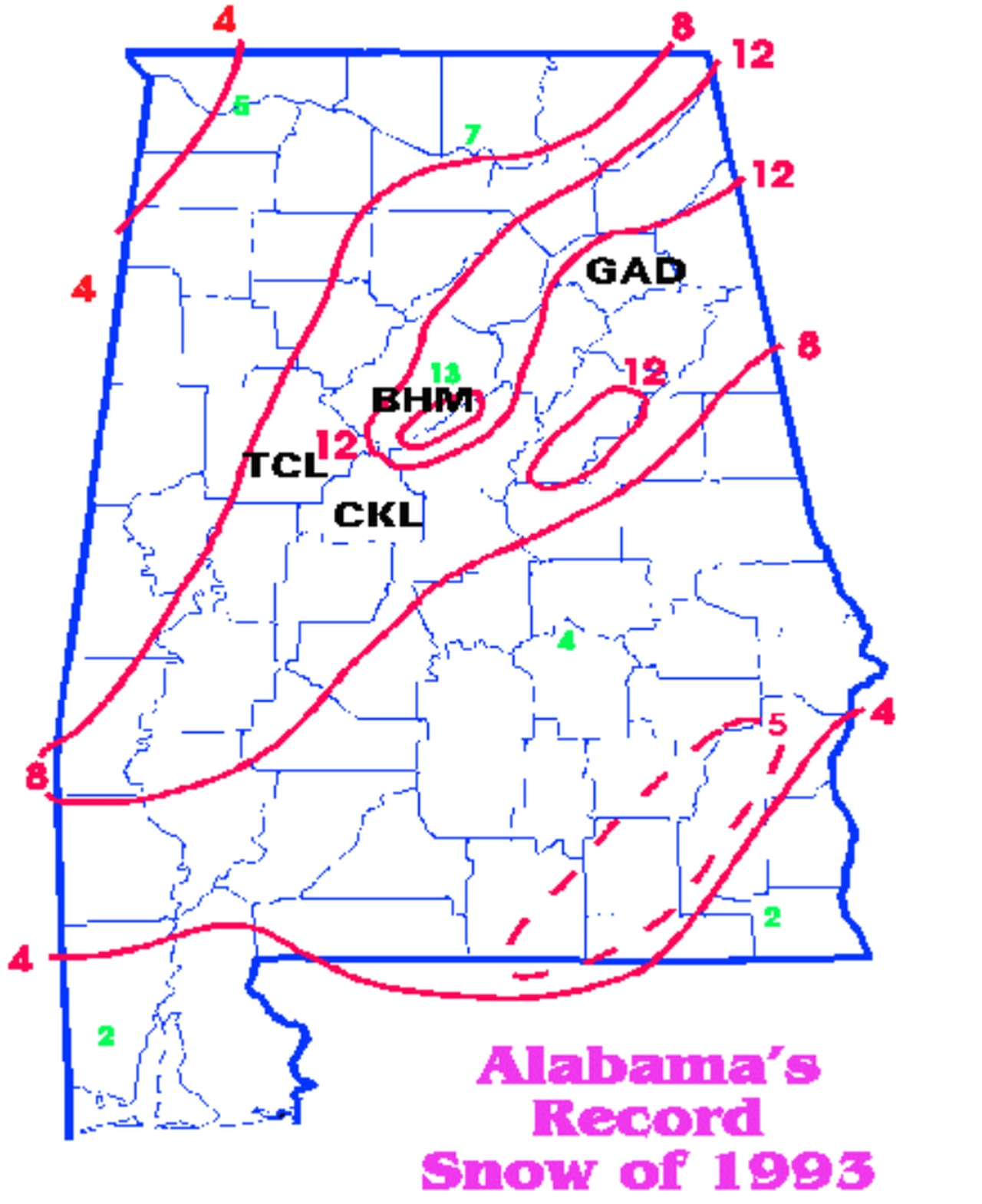How the blizzard of 1993 became Alabama’s ‘Storm of the Century’ 30 years ago
It’s known by many names. The “Storm of the Century,” the “1993 Superstorm,” or just “the winter storm in ‘93.”
But according to the National Weather Service, it’s commonly referred to as just “The Blizzard.”
And can you believe it happened three decades ago?
The 30th anniversary of the 1993 record snowfall is coming up on March 12-14 — but the effects from those three days lasted for much longer for many in the state — and the nation as well.
The Storm of the Century wreaked havoc through Alabama, the Southeast and up the East Coast.
Covering more than 550,000 square miles and impacting nearly 120 million people in the eastern U.S., the Storm of the Century still ranks as one of the worst snowstorms to affect the Southeast, as well as the Northeast and Ohio Valley, according to NOAA.
20
The Blizzard of 1993
It produced record-breaking snow, 11 tornadoes, 100-mph winds, hurricane-caliber coastal flooding and storm surge and intense cold. It was directly blamed for at least 100 deaths in the eastern U.S. — and some of those were in Alabama — as well as many more indirect deaths, hundreds of injuries and damage estimated at $2 billion, according to the weather service ($10.8 billion in 2021 dollars).
The extratropical storm was extraordinarily powerful and had a central pressure usually found in Category 3 hurricanes.
According to the weather service the area that experienced significant snowfall is among the most widespread of any storm ever recorded in the eastern U.S. Researchers estimated that the snow affected more than 90 million people in the U.S. alone.
That included people in all of Alabama’s 67 counties.
The powerful low pressure system took shape over the Gulf of Mexico early on March 12, 1993, and explosively strengthened, according to the weather service. It was strong enough to set numerous records for low pressure from Georgia to New York.
The storm pulled in extremely cold air behind it, and numerous record low temperatures were observed, including 2 degrees in Birmingham, 17 degrees in Montgomery and 21 degrees in Mobile, according to the weather service.
The storm was forecast well in advance, with weather models in unprecedented agreement that something big was brewing over the Gulf.
Light snow and rain began to fall in Alabama on the afternoon of March 12.
The weather service said that forecasters at the time had warned that this winter storm was going to be the real deal, but for a while the snow changed to rain and some Alabamians began to doubt it would amount to much.
They were very wrong.
During the overnight period of March 12 to 13, the rain changed back to snow. And it snowed, and snowed and snowed throughout the night.
There was even the rarely seen “thundersnow” in parts of Alabama, according to the weather service.
According to the weather service Birmingham officially recorded 13 inches of snow, which was the greatest amount ever recorded for any day, any month or any season at that site.
Here’s a look at how much snow Alabama got:
All of Alabama saw snow during the 1993 superstorm, with central and north Alabama getting the most — over a foot in some cases.
Some other Alabama snow totals from earlier AL.com reports:
17 inches at Valley Head
16 inches in Oneonta and Bessemer
13 inches at Anniston, Talladega, Pinson, Birmingham
12 inches at Thomasville, Childersburg, Scottsboro
11 inches at Sylacauga
10 inches at Cullman, Clanton and Heflin
9 inches in Thorsby
8 inches in Ashland, Centreville, Moulton and Guntersville
7 inches in Alexander City, Huntsville and Whatley
6 inches in Camden, Evergreen, Jasper, Livingston, Andalusia, Haleyville and Highland Home
5 inches in Auburn, Winfield, Muscle Shoals and Chatom
4 inches in Montgomery, Union Springs, Vernon, Tuscaloosa, Demopolis, Frisco City, Greenville, Troy
3 inches at Brewton, Hamilton, Bay Minette, Mobile Airport
2 inches at Atmore and Robertsdale
Trace at Fairhope and Coden
The snow paralyzed parts of the state, especially central and north Alabama, for up to a week.
According to NOAA, the 1993 superstorm marked the first time the weather service was able to forecast a storm of this magnitude five days in advance and provide storm and blizzard warnings two days in advance.
“This was unprecedented. The five-day lead time allowed the entire NWS to begin preparations well in advance of the storm and warn the 100,000,000 people in the eastern third of the United States of this impending natural disaster,” NOAA said. “Prior to the ‘Storm of the Century,’ the technology was not available to warn not only of a storm this far in advance, but also of its expected impacts.”
